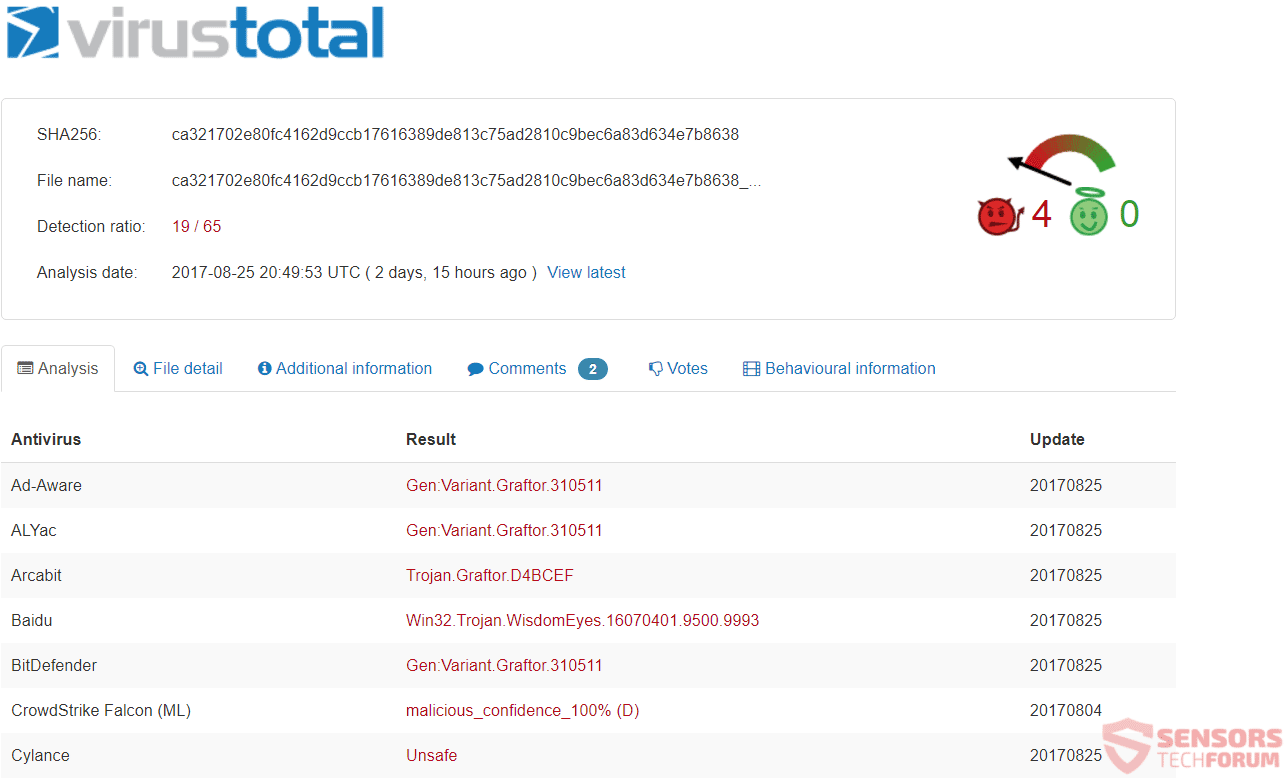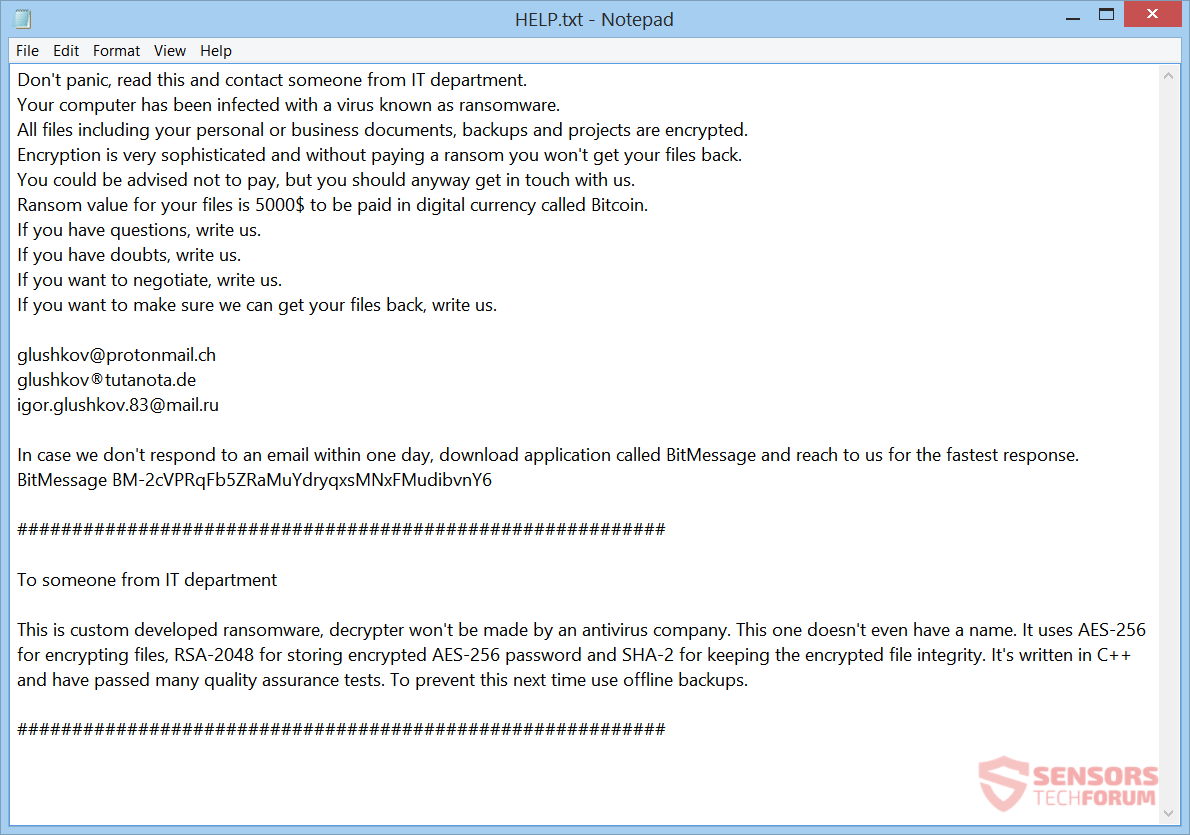This article will help you to remove Defray ransomware completely. Follow the ransomware removal instructions given at the end.
Defray is a ransomware virus targeting healthcare and educational organizations. The cryptovirus was dubbed “Defray” by researchers from Proofpoint, who were the first to discover this malware. They named it after one of the C2 (Command and Control) servers related with the threat. To defray means to give money to pay for an expense, which is appropriate here, since a ransom sum of 5,000 US dollars is demanded as payment. The Defray virus stores its ransom note message inside two text files. The files are filled with instructions about paying the abovementioned ransom for supposedly restoring your files. Read on below to see how you could try to potentially restore some of your data.

Threat Summary
| Name | Defray |
| Type | Ransomware, Cryptovirus |
| Short Description | The Defray ransomware targets large organizations and encrypts their files and then displays a ransom message afterward, demanding 5,000 US dollars. |
| Symptoms | The ransomware will encrypt files and put up a ransom note inside two text files. |
| Distribution Method | Spam Emails, Email Attachments |
| Detection Tool |
See If Your System Has Been Affected by malware
Download
Malware Removal Tool
|
User Experience | Join Our Forum to Discuss Defray. |
| Data Recovery Tool | Windows Data Recovery by Stellar Phoenix Notice! This product scans your drive sectors to recover lost files and it may not recover 100% of the encrypted files, but only few of them, depending on the situation and whether or not you have reformatted your drive. |

Defray Ransomware (Glushkov) – Infection Spread
Defray ransomware could spread its infection with various methods. The most current spread method is via fake Microsoft Word documents. The documents are attached to spam e-mails which are cleverly crafted to appeal to specific organizations. The campaigns are thin and the messages that are used are custom. Below you can view two of the most common documents and how they look like from the inside:
Images Source: Proofpoint
Inside these Microsoft Word file there is an embedded executable and according to Proofpoint – “an OLE packager shell object”. Clicking on the executable will trigger the payload dropper and consequently, execute the Defray ransomware. Some researchers have uploaded a malware sample on the VirusTotal service. You can see the detections of different security software there:
Defray ransomware might also distribute its payload file with other methods in the future. Refrain from opening files or clicking on them before scanning them with a security program. You should also check their size and signature for anything that seems suspicious. You should read the ransomware prevention tips thread in the forum.

Defray Ransomware (Glushkov) – Technical Overview
Defray is how Proofpoint researchers dubbed a ransomware virus that its own developers didn’t want to name. The name comes from one of the C2 (Command and Control) servers associated with the virus, specifically “defrayable-listings”. The malware encrypts files and extorts you to pay a ransom to supposedly recover them. For the moment organizations related to healthcare and education have been targeted as well as one big aquarium. The attacks are mostly targeting the United Kingdom and America.
Defray ransomware might make entries in the Windows Registry to achieve persistence, and could launch or repress processes in a Windows environment. Such entries are typically designed in a way to launch the virus automatically with each start of the Windows Operating System.
The ransom note can be previewed below, in the following screenshot:
The message is placed inside two files:
- FILES.txt
- HELP.txt
Their content reads the following:
Don’t panic, read this and contact someone from IT department.
Your computer has been infected with a virus known as ransomware.
All files including your personal or business documents, backups and projects are encrypted.
Encryption is very sophisticated and without paying a ransom you won’t get your files back.
You could be advised not to pay, but you should anyway get in touch with us.
Ransom value for your files is 5000$ to be paid in digital currency called Bitcoin.
If you have questions, write us.
If you have doubts, write us.
If you want to negotiate, write us.
If you want to make sure we can get your files back, write us.glushkov@protonmail.ch
glushkov®tutanota.de
igor.glushkov.83@mail.ruIn case we don’t respond to an email within one day, download application called BitMessage and reach to us for the fastest response.
BitMessage BM-2cVPRqFb5ZRaMuYdryqxsMNxFMudibvnY6###########################################################
To someone from IT department
This is custom developed ransomware, decrypter won’t be made by an antivirus company. This one doesn’t even have a name. It uses AES-256 for encrypting files, RSA-2048 for storing encrypted AES-256 password and SHA-2 for keeping the encrypted file integrity. It’s written in C++ and have passed many quality assurance tests. To prevent this next time use offline backups.
###########################################################
As seen above, the following three e-mails have been given for contacting the cybercriminals:
- glushkov@protonmail.ch
- glushkov®tutanota.de
- igor.glushkov.83@mail.ru
From these e-mails some researchers also refer to the cryptovirus as “Glushkov” ransomware.
The note of the Defray ransomware states that data is encrypted. You are demanded to pay 5,000 US dollars in the Bitcoin cryptocurrency. However, you should NOT under any circumstances pay the ransom sum. Your data may not get restored, and nobody could give you a guarantee for that. Furthermore, giving money to cybercriminals will most likely motivate them to create more ransomware viruses or do other criminal activities.

Defray Ransomware (Glushkov) – Encryption Process
The encryption process of the Defray ransomware is seems to be using a custom structure. According to the ransom note, the utilized encryption sequence is the following:
“AES-256 is used for encrypting the files, RSA-2048 for storing encrypted AES-256 password and SHA-2 for keeping the encrypted file integrity.”
The targeted extensions of files which are sought to get encrypted are listed right down here:
→.001, .3ds, .7zip, .MDF, .NRG, .PBF, .SQLITE, .SQLITE2, .SQLITE3, .SQLITEDB, .SVG, .UIF, .WMF, .abr, .accdb, .afi, .arw, .asm, .bkf, .c4d, .cab, .cbm, .cbu, .class, .cls, .cpp, .cr2, .crw, .csh, .csv, .dat, .dbx, .dcr, .dgn, .djvu, .dng, .doc, .docm, .docx, .dwfx, .dwg, .dxf, .exe, .fla, .fpx, .gdb, .gho, .ghs, .hdd, .html, .iso, .iv2i, .java, .key, .lcf, .lnk, .matlab, .max, .mdb, .mdi, .mrbak, .mrimg, .mrw, .nef, .odg, .ofx, .orf, .ova, .ovf, .pbd, .pcd, .pdf, .php, .pps, .ppsx, .ppt, .pptx, .pqi, .prn, .psb, .psd, .pst, .ptx, .pvm, .pzl, .qfx, .qif, .r00, .raf, .rar, .raw, .reg, .rw2, .s3db, .skp, .spf, .spi, .sql, .sqlite-journal, .stl, .sup, .swift, .tib, .txf, .u3d, .v2i, .vcd, .vcf, .vdi, .vhd, .vmdk, .vmem, .vmwarevm, .vmx, .vsdx, .wallet, .win, .xls, .xlsm, .xlsx, .zip
The Defray cryptovirus is set to disable startup recovery. Also, it erases all the Shadow Volume Copies from the Windows operating system with the help of the following command:
→vssadmin.exe delete shadows /all /Quiet
The above-stated command is executed and that makes the encryption process even more efficient. That is due to the fact that the command eliminates one of the prominent ways to restore your data. If your computer device was infected with this ransomware and your files are locked, read on through to find out how you could potentially recover your files.

Remove Defray Ransomware (Glushkov) and Restore Data
If your computer got infected with the Defray ransomware virus, you should have a bit of experience in removing malware. You should get rid of this ransomware as quickly as possible before it can have the chance to spread further and infect other computers. You should remove the ransomware and follow the step-by-step instructions guide provided below.
- Step 1
- Step 2
- Step 3
- Step 4
- Step 5
Step 1: Scan for Defray with SpyHunter Anti-Malware Tool



Ransomware Automatic Removal - Video Guide
Step 2: Uninstall Defray and related malware from Windows
Here is a method in few easy steps that should be able to uninstall most programs. No matter if you are using Windows 10, 8, 7, Vista or XP, those steps will get the job done. Dragging the program or its folder to the recycle bin can be a very bad decision. If you do that, bits and pieces of the program are left behind, and that can lead to unstable work of your PC, errors with the file type associations and other unpleasant activities. The proper way to get a program off your computer is to Uninstall it. To do that:


 Follow the instructions above and you will successfully delete most unwanted and malicious programs.
Follow the instructions above and you will successfully delete most unwanted and malicious programs.
Step 3: Clean any registries, created by Defray on your computer.
The usually targeted registries of Windows machines are the following:
- HKEY_LOCAL_MACHINE\Software\Microsoft\Windows\CurrentVersion\Run
- HKEY_CURRENT_USER\Software\Microsoft\Windows\CurrentVersion\Run
- HKEY_LOCAL_MACHINE\Software\Microsoft\Windows\CurrentVersion\RunOnce
- HKEY_CURRENT_USER\Software\Microsoft\Windows\CurrentVersion\RunOnce
You can access them by opening the Windows registry editor and deleting any values, created by Defray there. This can happen by following the steps underneath:


 Tip: To find a virus-created value, you can right-click on it and click "Modify" to see which file it is set to run. If this is the virus file location, remove the value.
Tip: To find a virus-created value, you can right-click on it and click "Modify" to see which file it is set to run. If this is the virus file location, remove the value.
Before starting "Step 4", please boot back into Normal mode, in case you are currently in Safe Mode.
This will enable you to install and use SpyHunter 5 successfully.
Step 4: Boot Your PC In Safe Mode to isolate and remove Defray





Step 5: Try to Restore Files Encrypted by Defray.
Method 1: Use STOP Decrypter by Emsisoft.
Not all variants of this ransomware can be decrypted for free, but we have added the decryptor used by researchers that is often updated with the variants which become eventually decrypted. You can try and decrypt your files using the instructions below, but if they do not work, then unfortunately your variant of the ransomware virus is not decryptable.
Follow the instructions below to use the Emsisoft decrypter and decrypt your files for free. You can download the Emsisoft decryption tool linked here and then follow the steps provided below:
1 Right-click on the decrypter and click on Run as Administrator as shown below:

2. Agree with the license terms:

3. Click on "Add Folder" and then add the folders where you want files decrypted as shown underneath:

4. Click on "Decrypt" and wait for your files to be decoded.

Note: Credit for the decryptor goes to Emsisoft researchers who have made the breakthrough with this virus.
Method 2: Use data recovery software
Ransomware infections and Defray aim to encrypt your files using an encryption algorithm which may be very difficult to decrypt. This is why we have suggested a data recovery method that may help you go around direct decryption and try to restore your files. Bear in mind that this method may not be 100% effective but may also help you a little or a lot in different situations.
Simply click on the link and on the website menus on the top, choose Data Recovery - Data Recovery Wizard for Windows or Mac (depending on your OS), and then download and run the tool.
Defray-FAQ
What is Defray Ransomware?
Defray is a ransomware infection - the malicious software that enters your computer silently and blocks either access to the computer itself or encrypt your files.
Many ransomware viruses use sophisticated encryption algorithms to make your files inaccessible. The goal of ransomware infections is to demand that you pay a ransom payment to get access to your files back.
What Does Defray Ransomware Do?
Ransomware in general is a malicious software that is designed to block access to your computer or files until a ransom is paid.
Ransomware viruses can also damage your system, corrupt data and delete files, resulting in the permanent loss of important files.
How Does Defray Infect?
Via several ways.Defray Ransomware infects computers by being sent via phishing emails, containing virus attachment. This attachment is usually masked as an important document, like an invoice, bank document or even a plane ticket and it looks very convincing to users.
Another way you may become a victim of Defray is if you download a fake installer, crack or patch from a low reputation website or if you click on a virus link. Many users report getting a ransomware infection by downloading torrents.
How to Open .Defray files?
You can't without a decryptor. At this point, the .Defray files are encrypted. You can only open them once they are decrypted using a specific decryption key for the particular algorithm.
What to Do If a Decryptor Does Not Work?
Do not panic, and backup the files. If a decryptor did not decrypt your .Defray files successfully, then do not despair, because this virus is still new.
Can I Restore ".Defray" Files?
Yes, sometimes files can be restored. We have suggested several file recovery methods that could work if you want to restore .Defray files.
These methods are in no way 100% guaranteed that you will be able to get your files back. But if you have a backup, your chances of success are much greater.
How To Get Rid of Defray Virus?
The safest way and the most efficient one for the removal of this ransomware infection is the use a professional anti-malware program.
It will scan for and locate Defray ransomware and then remove it without causing any additional harm to your important .Defray files.
Can I Report Ransomware to Authorities?
In case your computer got infected with a ransomware infection, you can report it to the local Police departments. It can help authorities worldwide track and determine the perpetrators behind the virus that has infected your computer.
Below, we have prepared a list with government websites, where you can file a report in case you are a victim of a cybercrime:
Cyber-security authorities, responsible for handling ransomware attack reports in different regions all over the world:
Germany - Offizielles Portal der deutschen Polizei
United States - IC3 Internet Crime Complaint Centre
United Kingdom - Action Fraud Police
France - Ministère de l'Intérieur
Italy - Polizia Di Stato
Spain - Policía Nacional
Netherlands - Politie
Poland - Policja
Portugal - Polícia Judiciária
Greece - Cyber Crime Unit (Hellenic Police)
India - Mumbai Police - CyberCrime Investigation Cell
Australia - Australian High Tech Crime Center
Reports may be responded to in different timeframes, depending on your local authorities.
Can You Stop Ransomware from Encrypting Your Files?
Yes, you can prevent ransomware. The best way to do this is to ensure your computer system is updated with the latest security patches, use a reputable anti-malware program and firewall, backup your important files frequently, and avoid clicking on malicious links or downloading unknown files.
Can Defray Ransomware Steal Your Data?
Yes, in most cases ransomware will steal your information. It is a form of malware that steals data from a user's computer, encrypts it, and then demands a ransom in order to decrypt it.
In many cases, the malware authors or attackers will threaten to delete the data or publish it online unless the ransom is paid.
Can Ransomware Infect WiFi?
Yes, ransomware can infect WiFi networks, as malicious actors can use it to gain control of the network, steal confidential data, and lock out users. If a ransomware attack is successful, it could lead to a loss of service and/or data, and in some cases, financial losses.
Should I Pay Ransomware?
No, you should not pay ransomware extortionists. Paying them only encourages criminals and does not guarantee that the files or data will be restored. The better approach is to have a secure backup of important data and be vigilant about security in the first place.
What Happens If I Don't Pay Ransom?
If you don't pay the ransom, the hackers may still have access to your computer, data, or files and may continue to threaten to expose or delete them, or even use them to commit cybercrimes. In some cases, they may even continue to demand additional ransom payments.
Can a Ransomware Attack Be Detected?
Yes, ransomware can be detected. Anti-malware software and other advanced security tools can detect ransomware and alert the user when it is present on a machine.
It is important to stay up-to-date on the latest security measures and to keep security software updated to ensure ransomware can be detected and prevented.
Do Ransomware Criminals Get Caught?
Yes, ransomware criminals do get caught. Law enforcement agencies, such as the FBI, Interpol and others have been successful in tracking down and prosecuting ransomware criminals in the US and other countries. As ransomware threats continue to increase, so does the enforcement activity.
About the Defray Research
The content we publish on SensorsTechForum.com, this Defray how-to removal guide included, is the outcome of extensive research, hard work and our team’s devotion to help you remove the specific malware and restore your encrypted files.
How did we conduct the research on this ransomware?
Our research is based on an independent investigation. We are in contact with independent security researchers, and as such, we receive daily updates on the latest malware and ransomware definitions.
Furthermore, the research behind the Defray ransomware threat is backed with VirusTotal and the NoMoreRansom project.
To better understand the ransomware threat, please refer to the following articles which provide knowledgeable details.
As a site that has been dedicated to providing free removal instructions for ransomware and malware since 2014, SensorsTechForum’s recommendation is to only pay attention to trustworthy sources.
How to recognize trustworthy sources:
- Always check "About Us" web page.
- Profile of the content creator.
- Make sure that real people are behind the site and not fake names and profiles.
- Verify Facebook, LinkedIn and Twitter personal profiles.





